Five Hydro Facilities Now!
The heart of the Connecticut River’s next 50 years.
 Since late 2012, five hydroelectric facilities in the heart of the Connecticut River have been in the process of renewing their operating licenses in a process known as relicensing. The licenses for two facilities in northern MA and three dams in southern VT and NH will endure for the next 30-50 years and impact more than 175 miles of the Connecticut River. It’s critical that we all speak up NOW in this once-in-a-lifetime opportunity to influence these operating licenses.
Since late 2012, five hydroelectric facilities in the heart of the Connecticut River have been in the process of renewing their operating licenses in a process known as relicensing. The licenses for two facilities in northern MA and three dams in southern VT and NH will endure for the next 30-50 years and impact more than 175 miles of the Connecticut River. It’s critical that we all speak up NOW in this once-in-a-lifetime opportunity to influence these operating licenses.
The three dams at Wilder, Bellows Falls and Vernon in New Hampshire and Vermont are owned by Great River Hydro (formerly TransCanada), a subsidiary of Hydro-Québec whose sole shareholder is the Government of Quebec. The two Massachusetts facilities, Turners Falls Dam and Northfield Mountain Pump Storage Project, are now separate LLCs under FirstLight Power Services LLC, owned by PSP Investments, one of Canada’s largest pension investment managers. The Federal Energy Regulatory Commission (FERC) last issued licenses for these facilities over forty years ago and all five licenses initially expired in April, 2018.
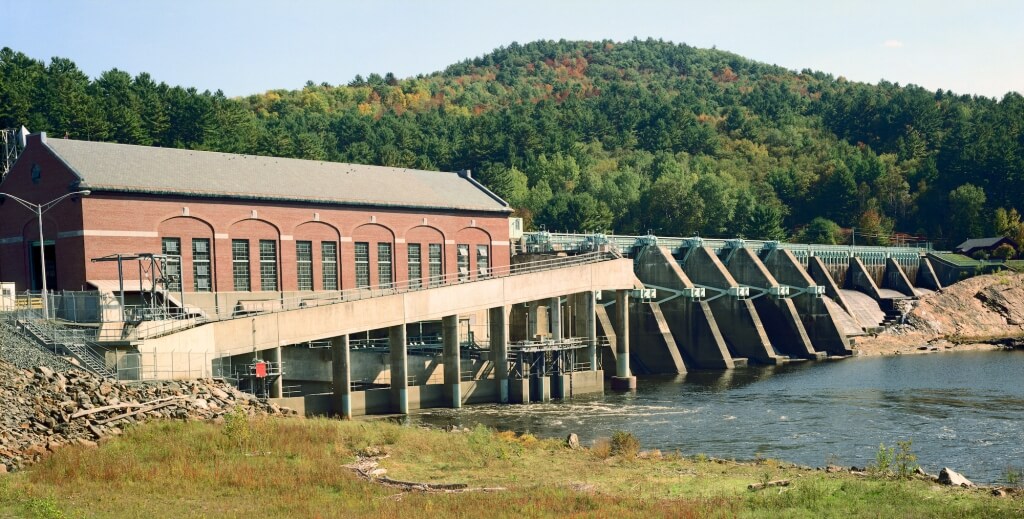
Wilder Dam, NH & VT
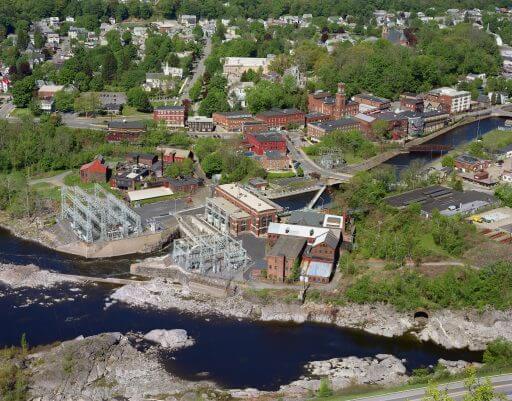
Bellows Falls Dam, NH & VT

Vernon Dam, NH & VT

Northfield Mountain Pumped Storage, MA
Tailrace – confluence with Connecticut River
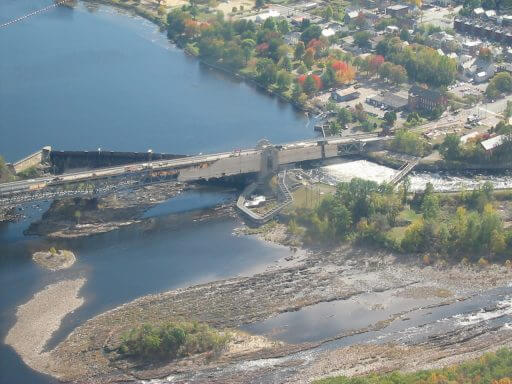
Turners Falls Dam, MA
Next Steps
Comments by local communities, the states, individuals, and other stakeholders provide a rare opportunity to improve the health of our river. The current relicensing process for these five hydropower facilities will dramatically affect the health of the river and watershed for generations to come. Anyone with thoughts or concerns can comment at any time and those comments become part of the official record for that project. You can see instructions below to formally submit comments to the Federal Energy Regulatory Commission (FERC), or sign up for our upcoming Hydropower Office Hours in March/April to connect with our staff and get your questions answered.
CRC river stewards Kathy Urffer (VT), Kate Buckman (NH), and Nina Gordon-Kirsch (MA) are participating in all the formal proceedings related to this relicensing effort. They review reports, prepare CRC comments, and are working to engage the public in the process. They are glad to answer any of your questions or speak to your group about the relicensing.
Both Great River Hydro and FirstLight submitted amended final license applications (AFLAs) in December 2020. And on February 22nd, 2024, FERC released a public notice indicating that the Turner’s Falls, Northfield Mountain, Vernon, Bellows Falls, and Wilder hydroelectric project applications have been accepted and are ready for environmental analysis. Link on the project name to see their respective notice. This opens a 60-day comment period that is currently active until April 22nd, 2024. It also starts the Clean Water Act Section 401 water quality certification clock and gives the companies 60 days to file an application with the state to apply for a water quality certificate.
Sign up for our ‘Hydropower Updates’ email news to be alerted of all major milestones and opportunities to engage as this process unfolds.
YOUR ROLE: YOU have a say!
Hydroelectric facilities use a public trust resource – your river – to produce power. In exchange for this privilege and to mitigate for impacts of the dams, FERC requires that hydropower operators provide direct benefits to the public and be protective of the ecological health of the river. The license serves as a public contract that we revisit periodically to examine the impact of the facility on our public trust resource.
It is important for the public and municipalities to submit comments to make sure that local concerns and desires are voiced during the relicensing process and are responded to as part of the new license. The Federal Energy Regulatory Commission (FERC) is interested in maintaining these energy facilities and they are in constant communication with the companies in the course of their relationship as regulators. FERC needs to hear from the public in order to understand and balance local ecological and public access concerns with power production
There are official comment periods at different stages of licensing and you can file comments, concerns, or complaints at any time…AND YOU SHOULD!
See the instructions below about how to submit comments. CRC encourages public participation and are glad to help answer any question that you may have.
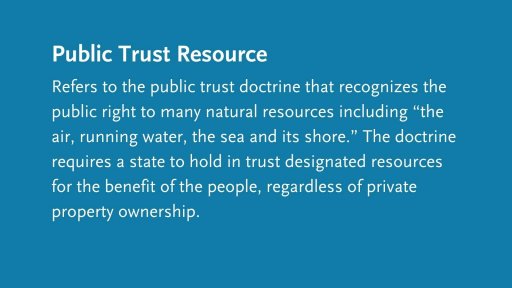
CRC’S ROLE
CRC’s desired outcomes and priority areas where CRC is advocating for change include:
- Safe, timely, and effective upstream and downstream fish passage
- Operational changes at the dams to minimize both upstream and downstream surface water fluctuations to reduce bank erosion and impacts to rare and threatened species
- Healthy aquatic habitat for river critters
- Seasonally appropriate minimum flows in the river channel
- Ecologically compatible and accessible recreational facilities
- Protection and interpretation of historic and archeological resources
- Equal consideration of Indigenous People’s traditional cultural properties
Video of our concerns about recreation:
Video of our concerns about erosion:

This work is funded in part by a grant from the New Hampshire Charitable Foundation.
How to Speak Up for Your Rivers
SUBMIT COMMENTS
To submit comments on a particular dam or hydro project you first need to know the Federal Energy Regulatory Commission (FERC) project number. There are many hydroelectric projects in the watershed. Click on the project in the map below to get more details. Comments can be in response to a particular filing or can be a complaint about project operations, safety, or recreation issues in the project areas.
Project numbers for the five large hydro facilities on the main stem Connecticut River undergoing relicensing now:
- Wilder Dam, P-1892
- Bellows Falls Dam, P-1855
- Vernon Dam, P-1904
- Northfield Mountain Pumped Storage Project, P-2485
- Turners Falls Dam, P-1889
There are two options for submitting comments to FERC:
- For a comment up to 6,000 characters, you can submit an e-comment. This DOES NOT require creating an account with FERC.
- For a longer comment, or to post a comment on your letterhead, you will need to eRegister with FERC to create an account, and then eFile.
Please see our FERC COMMENT GUIDE for extended comment details.
RESOURCES
Full License Applications submitted to the Federal Energy Regulatory Commission (FERC):
- Great River Hydro: Open “80-Amended-Final-License-Applications-AFLA” folder. Most information is in “Exhibit E.” CRC was concerned with information lacking in the AFLA so we submitted comments to FERC in January 2021.
- FirstLight: Executive Summary Table ES-1 shows inflated cost amounts that include a hidden expected energy revenue loss, whereas Exhibit D for the two facilities show lower costs. Otherwise, the Executive Summary is a concise summary of what the application package includes. CRC was concerned with information lacking in the AFLA so we submitted comments to FERC in January 2021.
Stay informed! Subscribe to the FERC docket using the project number (eg. Northfield Mountain Pump Station is P-2485) so you receive updates whenever comments are filed, or FERC issues a determination.
Research! Search the FERC eLibrary using the project number (eg. Northfield Mountain Pump Station is P-2485) for previously submitted comments, issuance, and documents.
CRC and Appalachian Mountain Club’s recreation recommendations submitted to FERC.
Recordings: CRC has been holding a number of virtual events to share information and answer questions. Visit CRC’s YouTube channel to see all past recordings.
FERC Comment Guide: review our comment guide to ensure your comments are submitted correctly.
Hydropower in NH & VT
Hydropower in MA
Hydro Relicensing and the 401 Water Quality Certificate:
States & Federal have a parallel process
All hydroelectric facilities must also apply for and receive a Water Quality Certificate from the state that that facility is located in. After submitting a revised final applications to FERC, hydro companies are required to apply for a 401 Clean Water Certificate. Anything the states require in this certificate will automatically be included in the final FERC license. Public comments submitted to the state during this process can have a positive impact on the long-term benefits for the river.
Most of the hydro facilities in our watershed are in Vermont, New Hampshire, and Massachusetts (click for more information on each state’s 401 process).
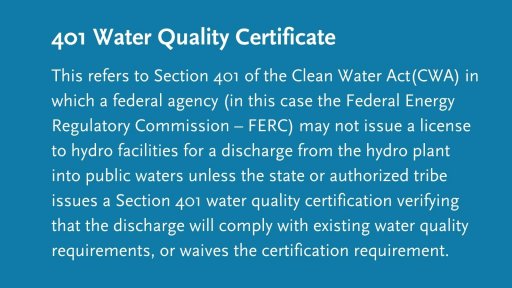
Background: Hydropower in the Connecticut River Watershed
All power generation has impacts on the environment. Hydropower has large impacts on a river. The Connecticut River watershed has dozens of active hydropower dams and two pumped storage projects that are regulated by the Federal Energy Regulatory Commission (FERC). Their individual and cumulative impacts to our rivers are massive. The Connecticut River is one of the most extensively dammed rivers in the nation. CRC has advocated for removing dams in our watershed that no longer serve a purpose. Thus far, we have aimed to minimize the impacts of operating hydropower dams rather than removal. However, we evaluate each facility on a case by case basis.
Dams on the main stem of the Connecticut River alter flows and water levels on more than 324 miles of the river’s 410 mile total length, from the headwaters region all the way down to Holyoke Dam 86 miles upstream from Long Island Sound. They block the movement of migratory and resident fish and other aquatic animals. The dams turn New England’s longest river into a series of warm water reservoirs. They impede natural river flows and cause the accumulation of sediment behind the dams, burying important river bottom habitat. Paddlers have to portage around the dams to continue traveling on the river. Historical uses and artifacts along the river are changed or submerged. It is important to remember the companies aren’t just managing their facilities, nor merely impacting just the water “at” the dams or nearby habitat. Through their presence and operations, hydro facilities manage the whole river.
Most hydropower facilities have a Federal Energy Regulatory Commission (FERC) license with a term of 40-50 years. When these operating licenses come up for renewal during the relicensing process, it is our once-in-a-lifetime opportunity to change how these hydro facilities affect our rivers. With such lengthy terms, the licenses lock-in impacts to the river for generations to come. Therefore, advocating for the river during relicensing is critical! It is a chance to improve access, habitat, and the river’s overall health as an ecosystem. Working with state and federal agencies, municipalities, nonprofits, and local residents, CRC examines the impacts of each facility’s operations on our local waterways and submits formal comments to ensure a balance between hydro operations and protection of the river.
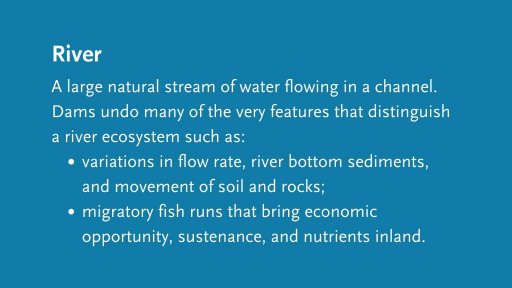
Tributary Facilities Undergoing Relicensing
The following facilities are currently undergoing relicensing.
Click the “+” to see the list and click links to see CRC’s comments.
P-10934 Sugar River II; Newport, NH on the Sugar River
P-9648 Fellows Dam, P-9649 Lovejoy, P-9650 Gilman and P-7888 Comtu Fall; Springfield, VT on the Black River
P-8615 Fiske Mill; Hinsdale, NH on the Ashuelot River
P-7887 Minnewawa Brook; Marlborough, NH on the Ashuelot River
P-7883 Weston; Groveton, NH on the Upper Ammonoosuc River
P-2490 Taftsville; Woodstock, VT on the Ottauquechee River
P-2489 Cavendish; Cavendish, VT on the Black River
P-2816 North Hartland; Hartland, VT on the Ottauquechee River
P-2839 Great Falls; Lyndonville, VT on the Passumpsic River
P-5261 Newbury; Newbury, VT on the Wells River
P-2392 Gilman; Lunenberg, VT and Dalton, NH on the Connecticut River
The Massachusetts facility has recently completed relicensing in Rowe and Florida, MA on the Deerfield River. The settlement agreement can be found here.
CRC’s Other Hydro Regulatory Work
LIHI attempts to reduce the impacts of hydropower generation through the certification of hydropower projects that have committed to environmental, cultural, and recreational stewardship. In some cases, certification allows these facilities to be eligible for access to renewable energy markets that they would not otherwise be able to derive revenue from. Currently, a LIHI certification lasts 5 years.
CRC routinely comments on LIHI applications to make sure that hydro-facilities are required to do the best that they possibly can for the river and our river communities. Additionally, CRC routinely participates in policy discussions and comments on LIHI policy and standards. Some examples of our LIHI comments can be found on our blog.
CRC is a member of the Hydropower Reform Coalition and supports advancing policy decisions to increase ecological and sustainable considerations in the hydro-power industry.
The 15-Mile Falls Project is a series of dams near Littleton, NH — the Moore, Comerford and McIndoes Falls dams, currently owned by Great River Hydro. These impoundments represent the largest single hydroelectric generating complex of dams in New England, affecting levels and flows from the Connecticut Lakes to the dam at Wilder, VT. CRC is a signatory to the 2001 landmark agreement guaranteeing increased river flows. The agreement established permanent easement protection on 9,200 watershed acres and created a $15 million Mitigation and Enhancement Fund. CRC continues to monitor license conditions and the workings of the M&E Fund.
The Holyoke Dam is the lowermost dam on the Connecticut River, controlling migratory fish access to 85% of the spawning habitat in the Connecticut River basin for American shad, blueback herring, shortnose sturgeon, and other species. CRC was part of a settlement agreement that was finalized in 2004. Post-relicensing work has kept us busy for more than a decade. Years of studies, designs, and meetings with Holyoke Gas & Electric finally led to the construction of upstream and downstream passage for shortnose sturgeon in 2015-2016. CRC reviews and comments on migratory fish passage reports and other studies that are released on an annual basis.
The Canaan Dam is located in Stewartstown, NH and Canaan, VT. This 275 foot-long dam and hydro-facility creates a 4,000 foot pond on the Connecticut River. During the 2009 relicensing, CRC and Trout Unlimited successfully requested that Vermont include a condition in their 401 Water Quality Certificate that the dam owner install fish passage at the request of the state. Although appealed by the dam owner to the VT Environmental Court, the condition remains in the VT 401 Certification and thereby is a condition of the FERC license.

